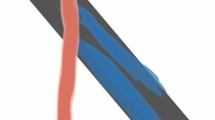Abstract
The interference of supersonic flows on the concave surface of conical wings was experimentally investigated in [1] for various values of the camber and angles of attack. In order to establish the detailed structure of the interference flow the laminar flow past a wing model in the form of half the surface of a circular cone with vertex angle 2θk = 34° was numerically modeled within the framework of the quasiconical approximation for the three-dimensional Navier-Stokes equations [2]. Under this assumption, confirmed by analysis of the experimental data [1], it was found that the displacement of the external inviscid flow as a result of intense flow separation beyond the leading edges leads to flow patterns similar to those realized on V wing's with a break in the transverse contour [3]. At nonzero angles of attack weak secondary separation was detected beneath the flattened regions of primary separation located in the shaded parts of the concave surface.
Similar content being viewed by others
Literature cited
V. V. Kravets and A. I. Shvets, “Separated flows on a concave conical wing,” Izv. Akad. Nauk SSSR, Mekh. Zhidk. Gaza, No. 2, 83 (1983).
D. S. McRae, “A numerical study of supersonic viscous cone flow at high angle of attack,” AIAA Paper, No. 97 11 (1976).
V. V. Kravets, “Realizable schemes of regular spatial intersection of two plane shocks,” Izv. Vyssh. Uchebn. Zaved. Aviats. Tekh., No. 3, 113 (1973).
R. W. MacCormack, “The effect of viscosity in hypervelocity impact cratering,” AIAA Paper, No. 35, 6 (1969).
R. G. Hindman, “Generalized coordinate forms of governing fluid equations and associated geometrically induced errors,” AIAA J.,20, 1359 (1982).
A. Stanbrook and L. C. Squire, “Possible types of flow at swept leading edges,” Aeronaut. Q.,15, 72 (1964).
V. Ya. Borovoi, Gas Flow and Heat Transfer in Shock Wave-Boundary Layer Interaction Zones [in Russian], Mashinostroenie, Moscow (1983).
M. Tobak and D. J. Peake, “Topology of two-dimensional and three-dimensional separated flows,” AIAA Paper, No. 1480, 29 (1979).
B. M. Bulakh, Nonlinear Conical Gas Flows [in Russian], Nauka, Moscow (1970).
P. K. Chang, Control of Flow Separation, Washington (1976).
Author information
Authors and Affiliations
Additional information
Translated from Izvestiya Akademii Nauk SSSR, Mekhanika Zhidkosti i Gaza, No. 4, pp. 130–136, July–August, 1989.
Rights and permissions
About this article
Cite this article
Borshch, V.L., Kravets, V.V. Separated flow over a strongly cambered conical wing at small angles of attack. Fluid Dyn 24, 599–604 (1989). https://doi.org/10.1007/BF01052424
Received:
Issue Date:
DOI: https://doi.org/10.1007/BF01052424



